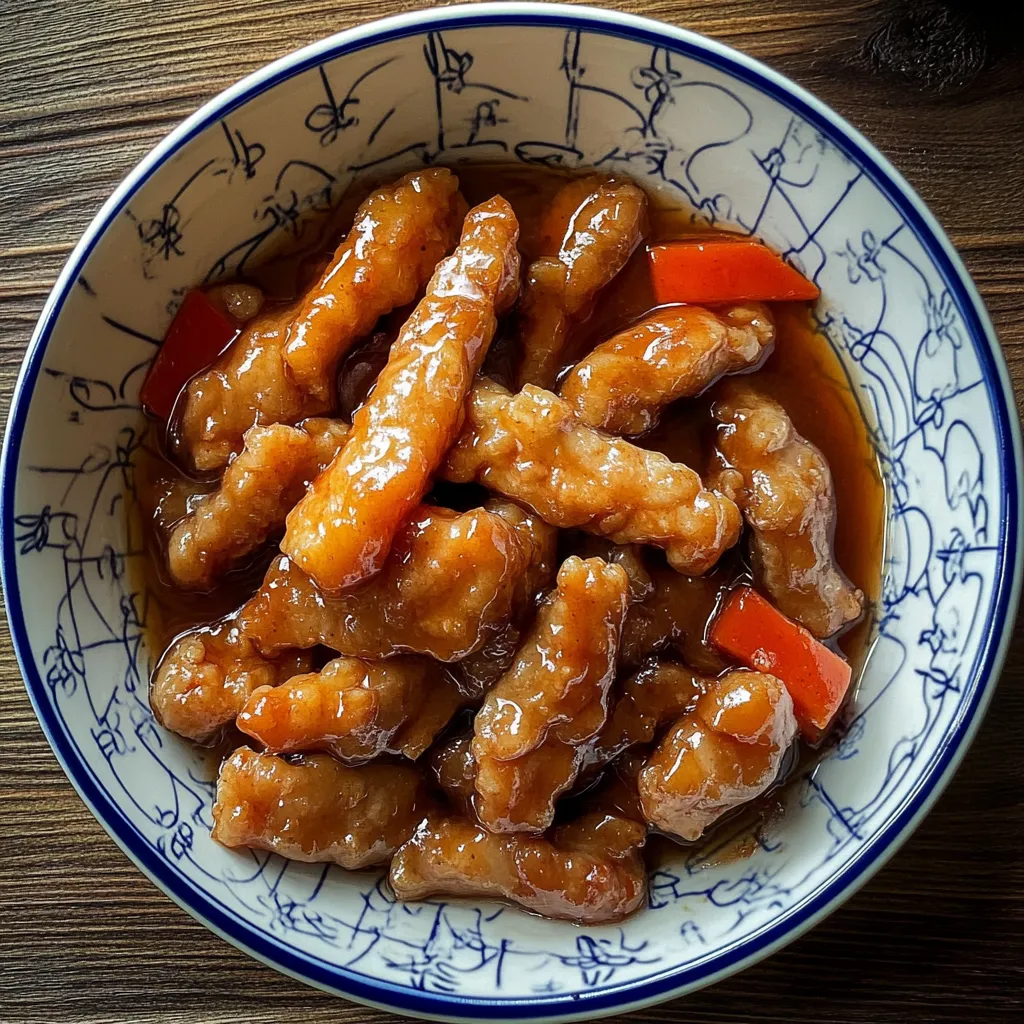 Pin it
Pin it
This sweet and sour pork recipe came into my life after years of disappointment with takeout versions that were either too sweet, too goopy, or filled with more batter than actual meat. After my grandmother passed away, I found her handwritten recipe cards, including this gem that had been passed down through generations since my family immigrated from Southern China. The first time I made it, the familiar aroma filled my kitchen and suddenly I was eight years old again, watching her nimble hands working the wok. This version balances tangy vinegar with just enough sweetness, while the five-spice powder adds that complex, aromatic depth that many restaurant versions lack. What makes this truly special is how the marinade infuses the meat overnight, creating flavor that goes beyond just the crispy exterior.
Last month I made this for my best friend who always orders sweet and sour pork from our local Chinese restaurant. She took one bite and looked genuinely confused, then said, "Wait, this is what sweet and sour pork is supposed to taste like?" Her husband, who normally "doesn't like Chinese food," asked for seconds and then hovered around the kitchen looking for leftovers. There's something about the authentic balance of flavors here that makes it completely different from what most people expect.
Secret Ingredients
- Pork scotch (neck/collar) creates juicier results than leaner cuts – the marbling of fat prevents the meat from drying out during frying
- Chinese dark vinegar brings that distinctive tangy depth that regular vinegar can't match – though balsamic makes a decent substitute in a pinch
- Five spice powder might seem like a small addition, but it creates that authentic Chinese flavor profile that most restaurant versions lack
- The 2:1 ratio of cornstarch to flour in the coating creates that distinctive crispy-yet-light texture that's hard to achieve with flour alone
- Rice wine adds subtle complexity to the marinade – don't skip this if you can help it
 Pin it
Pin it
Step-by-Step Instructions
- The marinade needs time to work its magic.
- First time I made this, I rushed and only marinated for an hour – good, but nothing special. When I followed Grandma's overnight instruction, the difference was dramatic. The pork becomes infused with flavor all the way through, not just on the surface.
- Getting the oil temperature right is crucial.
- Too hot and the outside burns before the inside cooks; too cool and the meat absorbs oil like a sponge. I've found that testing with a small piece is more reliable than a thermometer – when it immediately sizzles and rises to the surface, you're good to go.
- That moment when you add the pork to the hot oil can be intimidating.
- My first attempt, I nervously dropped pieces in one by one from a distance and got splattered. Now I use long cooking chopsticks to gently lower them in close to the oil's surface – much safer and more controlled.
- The coating technique took some practice.
- Initially, I dumped all the starch and flour in at once and ended up with gummy patches. Now I sprinkle it gradually while tossing, almost like salting a dish, which creates a much more even coating.
- Don't be tempted to crowd the pan when frying.
- My impatient attempt to cook it all at once resulted in a dramatic drop in oil temperature and soggy pork. Working in small batches keeps the oil hot and gives you that perfect crispy exterior.
My first attempts at this recipe were pretty faithful to my grandmother's card, but I've made subtle adjustments over time. She used a more traditional 50/50 mix of white vinegar and black vinegar, but I prefer the deeper flavor that comes from using primarily Chinese dark vinegar. I've experimented with different cuts of pork, including tenderloin for a leaner option, but always come back to scotch for its superior moisture and flavor when deep fried.
Serving Suggestions
Serve this with plain steamed rice to let the complex flavors of the pork take center stage. For a complete meal, I add a simple side of stir-fried bok choy with garlic. If you're serving this for a dinner party, arrange on a platter with fresh cilantro leaves scattered on top for color. This also works beautifully as part of a larger Chinese feast alongside mapo tofu, steamed fish, and vegetable dishes.
Tasty Variations
Try the same marinade and coating technique with chicken thigh pieces for a different protein option. For a more substantial dish, stir-fry bell peppers, pineapple chunks, and onions separately and toss with the fried pork just before serving. Around Chinese New Year, I sometimes add dried orange peel to the marinade for a subtle citrus note that symbolizes good fortune. If you prefer a saucier version, reserve the marinade (before adding any raw meat), boil it for food safety, then thicken with a cornstarch slurry to serve alongside.
Storage Smarts
This pork freezes surprisingly well for a fried dish. Let it cool completely, then freeze in single-portion containers for up to 3 months. To reheat, don't microwave or it'll get soggy – instead, place in a 350°F oven for about 10 minutes until heated through and crispy again. If you're making this ahead for a party, you can fry the pork a few hours in advance and keep it warm in a low oven (200°F) on a wire rack over a baking sheet, which helps maintain the crispiness.
 Pin it
Pin it
I've made this sweet and sour pork countless times since finding my grandmother's recipe card – for family dinners, homesick friends, Chinese New Year celebrations, and frankly, just for myself on days when I need comfort food with a connection to my heritage. There's something deeply satisfying about recreating a dish that's been in my family for generations, especially one that tastes so much better than what most people associate with "sweet and sour pork." Every time I make it, the aroma brings back memories of standing on a stool in my grandmother's kitchen, eager to learn her secrets. Now when friends ask where I got such an amazing recipe, I get to say, "My grandmother," and feel that connection across time.
Frequently Asked Questions
- → Can I use a different cut of pork?
- Yes! While pork scotch (collar/neck) is recommended for its moisture, you can use pork tenderloin for a leaner option. Just be aware it may be slightly less juicy when fried.
- → What can I substitute for Chinese dark vinegar?
- Balsamic vinegar is the best substitute. Look for Zhenjiang vinegar (yellow label) if you want the authentic flavor, but good quality balsamic works well.
- → Can I make this gluten-free?
- Yes, use gluten-free soy sauce and replace the regular flour with rice flour or more cornstarch for a fully gluten-free version.
- → How long can I keep the marinated pork before cooking?
- For best results, marinate overnight or at least 4 hours. You can keep the marinated pork in the refrigerator for up to 2 days before cooking.
- → Can I freeze the cooked sweet and sour pork?
- Yes! This dish freezes well. Cool completely, then store in airtight containers for up to 3 months. Reheat in the oven for best texture results rather than microwave.
